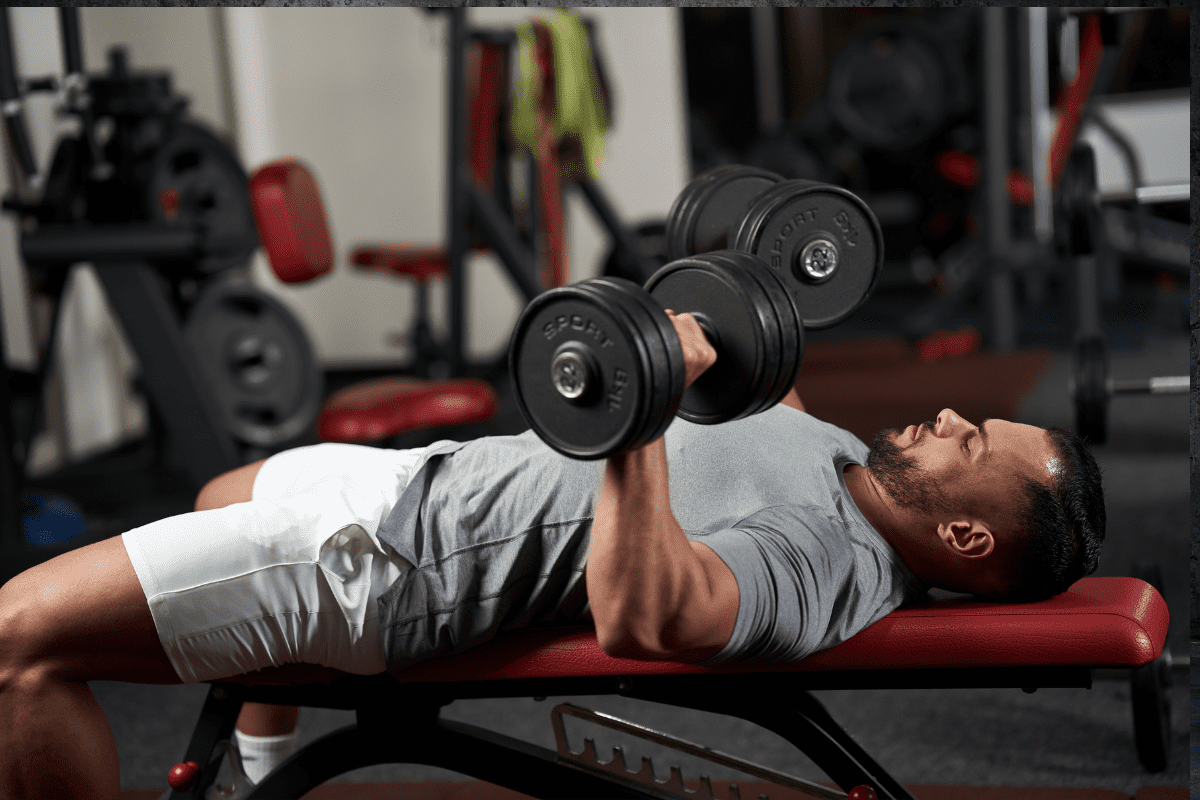Dumbbell Bench Press (How To, Muscles Worked, Benefits)
One of my personal favorite movements, the dumbbell bench press is a fantastic upper-body strength exercise.
The variability of the dumbbell bench press has proved to be helpful for court and field athletes, powerlifters, and general population lifters.
In this guide, I will be going over how to dumbbell bench press, coaching points, common mistakes, and alternatives if you happen to need them.
How To Dumbbell Bench Press
Equipment Needed
- Dumbbells
- Bench
Step-by-Step Instruction
- Grab your dumbbells, sit on the edge of the bench, and sit the dumbbells on your thighs vertically.
- Take a deep breath, lie flat on your back on the bench, and get your dumbbells in position ready to press.
- Keep your feet flat on the floor.
- Keep your butt on the bench.
- Pull your shoulder blades together and keep the back of your head on the bench. You will slightly arch your back. Keep your core tight and keep the shoulder blades pulled back tight.
- The dumbbells should be slightly angled (representative of the path you are descending with your elbows).
- Press the dumbbells up.
- Control the dumbbells down during the eccentric movement and draw the dumbbells in, keeping the elbows at about a 45-degree angle away from the torso.
- The dumbbells will make contact with your torso right at the nipple line on the chest.
- Once contact is made, drive the dumbbells back up.
- When your set is done, do not freely drop the dumbbells without checking your surroundings. You could drop the dumbbell and it might hit a person nearby. Or your could drop your dumbbell and crush your fingers on a dumbbell that was left next to your bench.
- The best way to finish a set is to bring the dumbbells back to your thighs and stand up with them. Or have a lifting partner take them from you.
Coaching Points
This is a very shoulder-friendly pressing movement. Because the implement is a dumbbell, the range of motion is increased, the shear force on the shoulder is decreased, and the shoulder stabilizing muscles are engaged.
I would highly recommend this movement to any athlete. It provides all the benefits that a pressing movement can offer with minimal risk.
Remember to finish your sets with awareness so that you and your training partner/fellow gym members stay safe and injury-free.
Common Mistakes
- Do not over arch the back or let your butt come off the bench. Most professionals will not accept repetitions if the butt comes off the bench but also you will likely injure yourself with poor form.
- Do not let the back of your head come off the bench because you are pulling down on your neck to watch the bar hit your chest. You will get used to the movement and your peripheral vision will allow you to know when the bar makes contact.
- Do not let the elbows flare out away from the midline. The shoulders are incredibly vulnerable in these positions and the sheer force placed on the shoulders will lead to injury if the technique is not made a priority.
Benefits of Dumbbell Bench Press
Some of the benefits of Dumbbell Bench Press include:
- It allows for a greater range of motion than a barbell bench press, which can help to target the muscles more effectively.
- It can help to improve muscle imbalances, as each arm is working independently during the exercise.
- It can be performed with lighter weights, which can be useful for beginners or those who are recovering from an injury.
- It can help to improve overall upper body strength and hypertrophy.
Overall, the dumbbell bench press is a versatile exercise that can be incorporated into a variety of strength training routines to help improve overall upper body strength and muscle development.
Muscles Worked
- Chest
- Shoulders
- Triceps
- Biceps (Isometric and eccentric contributors)
Dumbbell Bench Press Alternatives
Need an alternative for Dumbbell Bench Press? Here are a few exercises you may be able to try as a replacement.
Want even more options? Here are 10 of my favorite alternatives for Dumbbell Bench Press for chest development.
Dumbbell Floor Press
Grab your dumbbells and perform your pressing movement without a bench.
Lie down right on the floor and perform the dumbbell bench press movement. This movement is even more shoulder-friendly due to the eccentric movement stopping at the torso.
Barbell Push-Ups
Set the barbell on the lifting rack at a low setting. Perform push-ups with your bench press grip. This is a great movement for lifters to get some volume with the same implement but now the scapula can freely rotate and is a little more shoulder-friendly.
Medicine Ball Chest Pass
Stand in an athletic position with a lighter med ball (for most, 10-15 pounds will work well here). Extend the hips and chest pass the ball into the wall. This should be fast and explosive.
I believe Med Ball Chest Pass is a great warm-up exercise for athletes getting ready for a bench day.
More Info and Links
Looking for some more great supplemental work for your bench day? Head over to our Exercise Library to find step-by-step exercises to help you crush a personal record.

